Comprehensive Analysis of the Australian Court System and Precedent
VerifiedAdded on 2021/11/21
|8
|2183
|119
Essay
AI Summary
This paper provides a comprehensive overview of the Australian court system. It begins by exploring the doctrine of precedent and its application within the court hierarchy, followed by an analysis of the relationship between Common Law and Statute Law. The paper then examines the structure of the Commonwealth Judiciary, focusing on the High Court of Australia, its jurisdiction, and its role in constitutional interpretation and judicial review. The discussion covers the evolution of the High Court's influence, its interaction with international standards, and the balance between judicial activism and parliamentary sovereignty. The essay highlights the positive aspects of the system, such as the protection of human rights, while also acknowledging its limitations regarding international standards. The paper concludes by summarizing the key features of the Australian court system and its unique characteristics, emphasizing the influence of British parliamentary tradition and the challenges in achieving genuine judicial protection of individual rights.
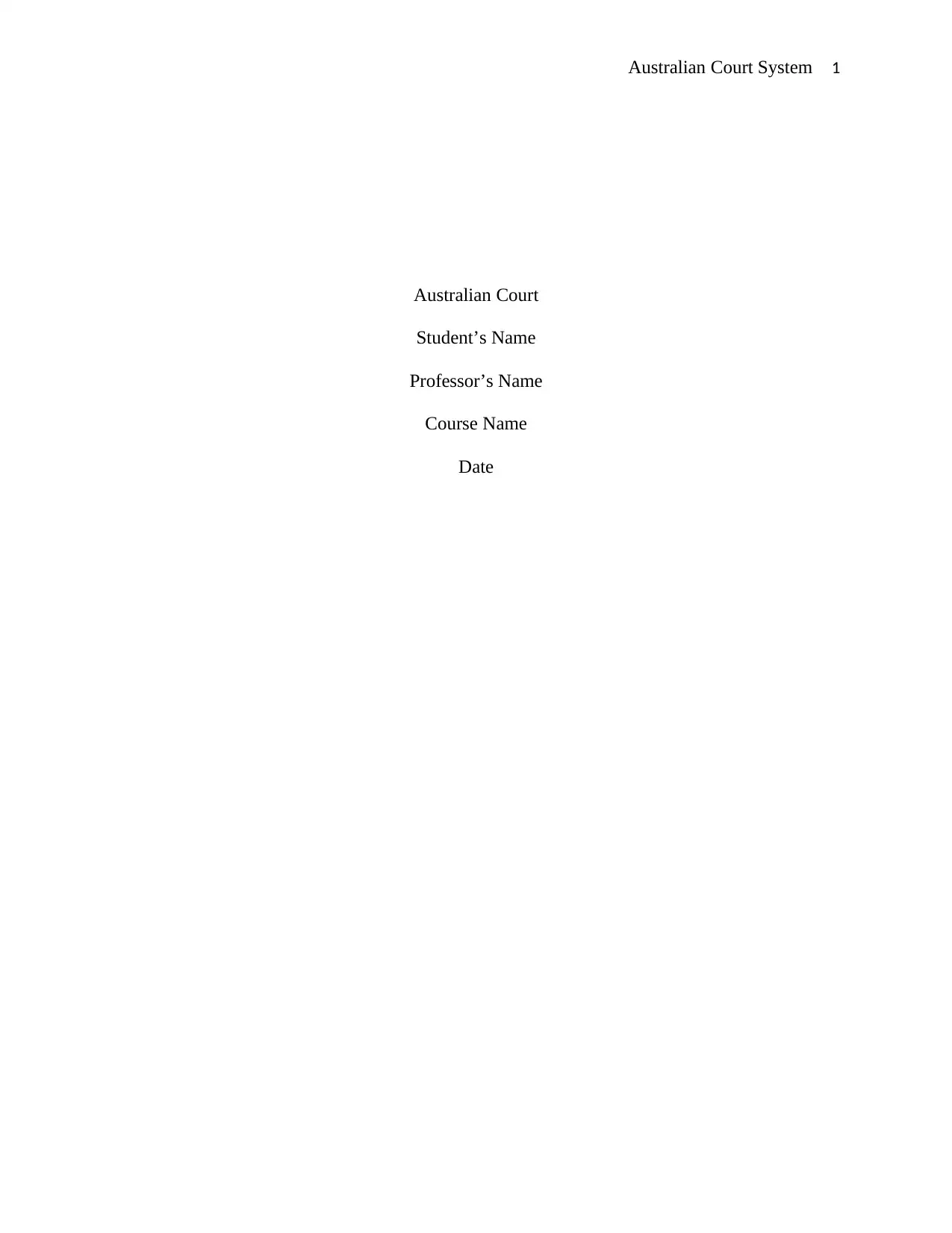
Australian Court System 1
Australian Court
Student’s Name
Professor’s Name
Course Name
Date
Australian Court
Student’s Name
Professor’s Name
Course Name
Date
Paraphrase This Document
Need a fresh take? Get an instant paraphrase of this document with our AI Paraphraser
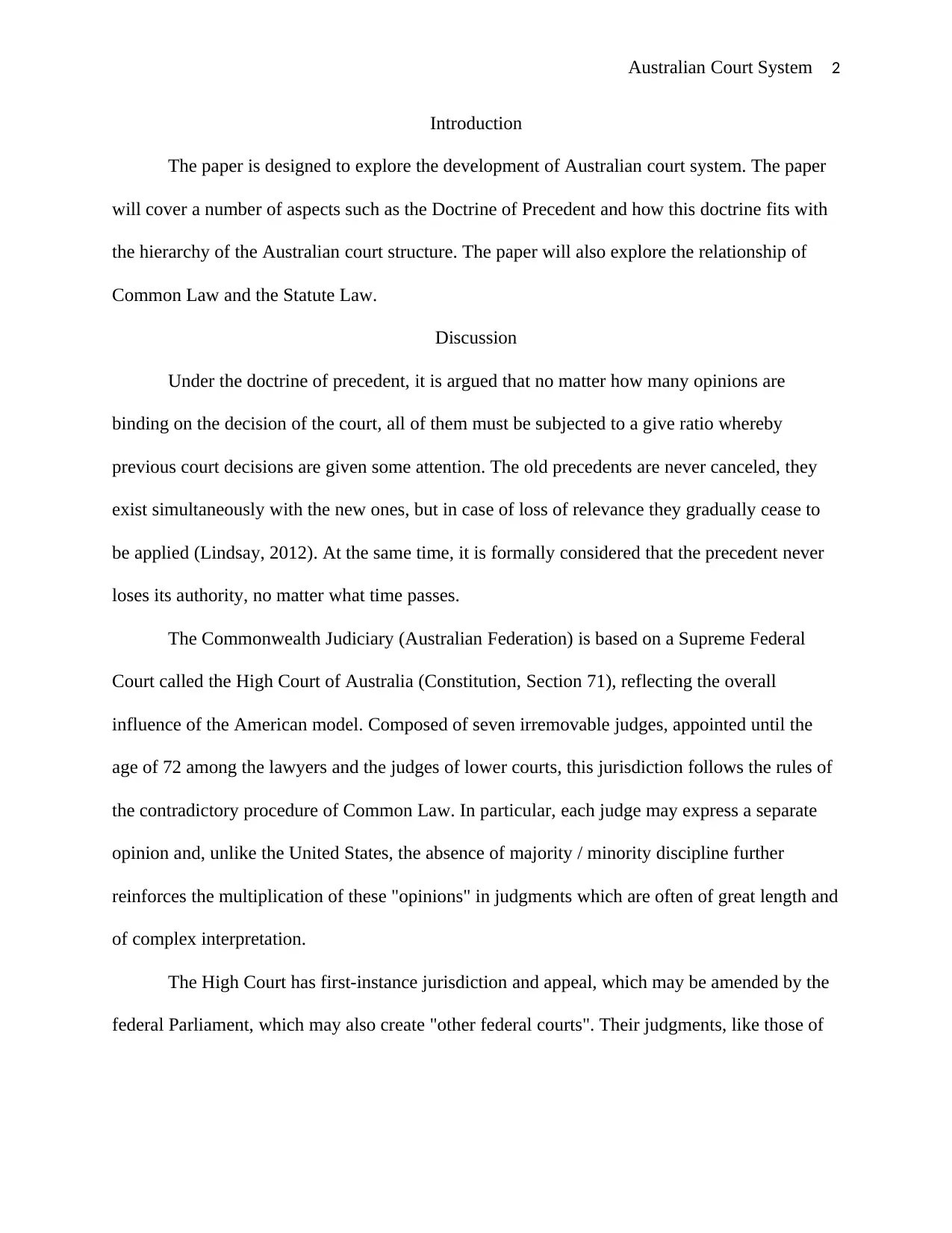
Australian Court System 2
Introduction
The paper is designed to explore the development of Australian court system. The paper
will cover a number of aspects such as the Doctrine of Precedent and how this doctrine fits with
the hierarchy of the Australian court structure. The paper will also explore the relationship of
Common Law and the Statute Law.
Discussion
Under the doctrine of precedent, it is argued that no matter how many opinions are
binding on the decision of the court, all of them must be subjected to a give ratio whereby
previous court decisions are given some attention. The old precedents are never canceled, they
exist simultaneously with the new ones, but in case of loss of relevance they gradually cease to
be applied (Lindsay, 2012). At the same time, it is formally considered that the precedent never
loses its authority, no matter what time passes.
The Commonwealth Judiciary (Australian Federation) is based on a Supreme Federal
Court called the High Court of Australia (Constitution, Section 71), reflecting the overall
influence of the American model. Composed of seven irremovable judges, appointed until the
age of 72 among the lawyers and the judges of lower courts, this jurisdiction follows the rules of
the contradictory procedure of Common Law. In particular, each judge may express a separate
opinion and, unlike the United States, the absence of majority / minority discipline further
reinforces the multiplication of these "opinions" in judgments which are often of great length and
of complex interpretation.
The High Court has first-instance jurisdiction and appeal, which may be amended by the
federal Parliament, which may also create "other federal courts". Their judgments, like those of
Introduction
The paper is designed to explore the development of Australian court system. The paper
will cover a number of aspects such as the Doctrine of Precedent and how this doctrine fits with
the hierarchy of the Australian court structure. The paper will also explore the relationship of
Common Law and the Statute Law.
Discussion
Under the doctrine of precedent, it is argued that no matter how many opinions are
binding on the decision of the court, all of them must be subjected to a give ratio whereby
previous court decisions are given some attention. The old precedents are never canceled, they
exist simultaneously with the new ones, but in case of loss of relevance they gradually cease to
be applied (Lindsay, 2012). At the same time, it is formally considered that the precedent never
loses its authority, no matter what time passes.
The Commonwealth Judiciary (Australian Federation) is based on a Supreme Federal
Court called the High Court of Australia (Constitution, Section 71), reflecting the overall
influence of the American model. Composed of seven irremovable judges, appointed until the
age of 72 among the lawyers and the judges of lower courts, this jurisdiction follows the rules of
the contradictory procedure of Common Law. In particular, each judge may express a separate
opinion and, unlike the United States, the absence of majority / minority discipline further
reinforces the multiplication of these "opinions" in judgments which are often of great length and
of complex interpretation.
The High Court has first-instance jurisdiction and appeal, which may be amended by the
federal Parliament, which may also create "other federal courts". Their judgments, like those of
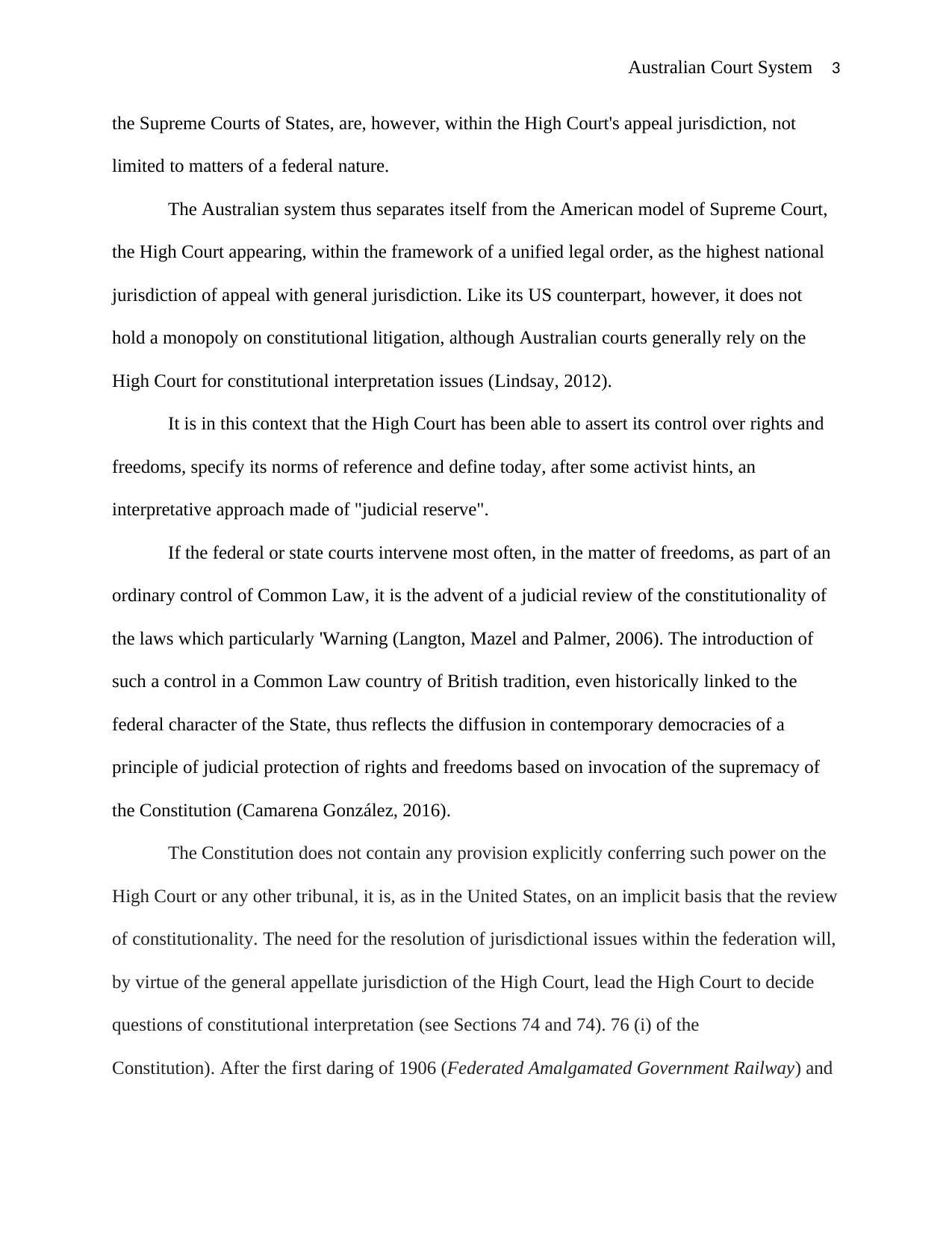
Australian Court System 3
the Supreme Courts of States, are, however, within the High Court's appeal jurisdiction, not
limited to matters of a federal nature.
The Australian system thus separates itself from the American model of Supreme Court,
the High Court appearing, within the framework of a unified legal order, as the highest national
jurisdiction of appeal with general jurisdiction. Like its US counterpart, however, it does not
hold a monopoly on constitutional litigation, although Australian courts generally rely on the
High Court for constitutional interpretation issues (Lindsay, 2012).
It is in this context that the High Court has been able to assert its control over rights and
freedoms, specify its norms of reference and define today, after some activist hints, an
interpretative approach made of "judicial reserve".
If the federal or state courts intervene most often, in the matter of freedoms, as part of an
ordinary control of Common Law, it is the advent of a judicial review of the constitutionality of
the laws which particularly 'Warning (Langton, Mazel and Palmer, 2006). The introduction of
such a control in a Common Law country of British tradition, even historically linked to the
federal character of the State, thus reflects the diffusion in contemporary democracies of a
principle of judicial protection of rights and freedoms based on invocation of the supremacy of
the Constitution (Camarena González, 2016).
The Constitution does not contain any provision explicitly conferring such power on the
High Court or any other tribunal, it is, as in the United States, on an implicit basis that the review
of constitutionality. The need for the resolution of jurisdictional issues within the federation will,
by virtue of the general appellate jurisdiction of the High Court, lead the High Court to decide
questions of constitutional interpretation (see Sections 74 and 74). 76 (i) of the
Constitution). After the first daring of 1906 (Federated Amalgamated Government Railway) and
the Supreme Courts of States, are, however, within the High Court's appeal jurisdiction, not
limited to matters of a federal nature.
The Australian system thus separates itself from the American model of Supreme Court,
the High Court appearing, within the framework of a unified legal order, as the highest national
jurisdiction of appeal with general jurisdiction. Like its US counterpart, however, it does not
hold a monopoly on constitutional litigation, although Australian courts generally rely on the
High Court for constitutional interpretation issues (Lindsay, 2012).
It is in this context that the High Court has been able to assert its control over rights and
freedoms, specify its norms of reference and define today, after some activist hints, an
interpretative approach made of "judicial reserve".
If the federal or state courts intervene most often, in the matter of freedoms, as part of an
ordinary control of Common Law, it is the advent of a judicial review of the constitutionality of
the laws which particularly 'Warning (Langton, Mazel and Palmer, 2006). The introduction of
such a control in a Common Law country of British tradition, even historically linked to the
federal character of the State, thus reflects the diffusion in contemporary democracies of a
principle of judicial protection of rights and freedoms based on invocation of the supremacy of
the Constitution (Camarena González, 2016).
The Constitution does not contain any provision explicitly conferring such power on the
High Court or any other tribunal, it is, as in the United States, on an implicit basis that the review
of constitutionality. The need for the resolution of jurisdictional issues within the federation will,
by virtue of the general appellate jurisdiction of the High Court, lead the High Court to decide
questions of constitutional interpretation (see Sections 74 and 74). 76 (i) of the
Constitution). After the first daring of 1906 (Federated Amalgamated Government Railway) and
⊘ This is a preview!⊘
Do you want full access?
Subscribe today to unlock all pages.

Trusted by 1+ million students worldwide
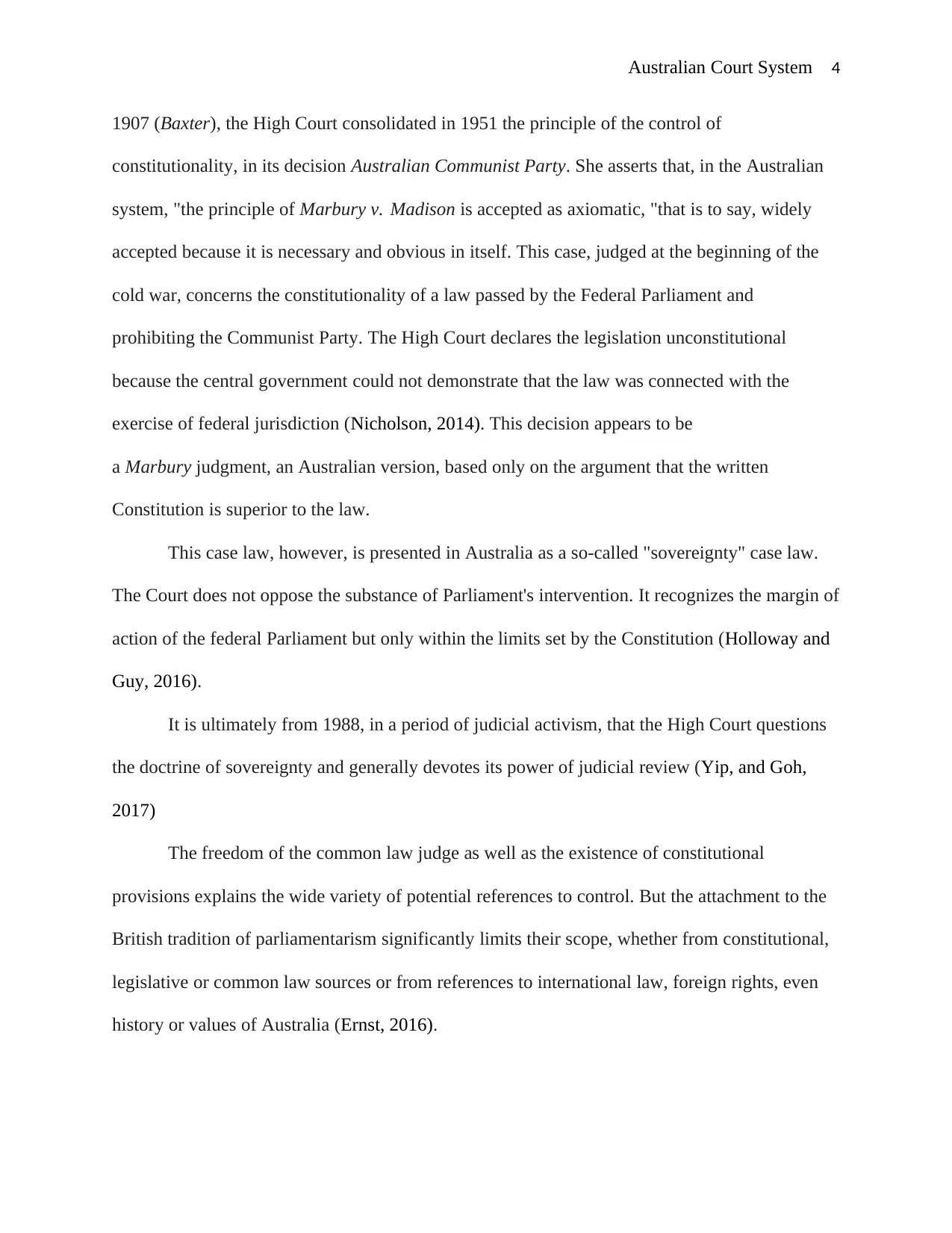
Australian Court System 4
1907 (Baxter), the High Court consolidated in 1951 the principle of the control of
constitutionality, in its decision Australian Communist Party. She asserts that, in the Australian
system, "the principle of Marbury v. Madison is accepted as axiomatic, "that is to say, widely
accepted because it is necessary and obvious in itself. This case, judged at the beginning of the
cold war, concerns the constitutionality of a law passed by the Federal Parliament and
prohibiting the Communist Party. The High Court declares the legislation unconstitutional
because the central government could not demonstrate that the law was connected with the
exercise of federal jurisdiction (Nicholson, 2014). This decision appears to be
a Marbury judgment, an Australian version, based only on the argument that the written
Constitution is superior to the law.
This case law, however, is presented in Australia as a so-called "sovereignty" case law.
The Court does not oppose the substance of Parliament's intervention. It recognizes the margin of
action of the federal Parliament but only within the limits set by the Constitution (Holloway and
Guy, 2016).
It is ultimately from 1988, in a period of judicial activism, that the High Court questions
the doctrine of sovereignty and generally devotes its power of judicial review (Yip, and Goh,
2017)
The freedom of the common law judge as well as the existence of constitutional
provisions explains the wide variety of potential references to control. But the attachment to the
British tradition of parliamentarism significantly limits their scope, whether from constitutional,
legislative or common law sources or from references to international law, foreign rights, even
history or values of Australia (Ernst, 2016).
1907 (Baxter), the High Court consolidated in 1951 the principle of the control of
constitutionality, in its decision Australian Communist Party. She asserts that, in the Australian
system, "the principle of Marbury v. Madison is accepted as axiomatic, "that is to say, widely
accepted because it is necessary and obvious in itself. This case, judged at the beginning of the
cold war, concerns the constitutionality of a law passed by the Federal Parliament and
prohibiting the Communist Party. The High Court declares the legislation unconstitutional
because the central government could not demonstrate that the law was connected with the
exercise of federal jurisdiction (Nicholson, 2014). This decision appears to be
a Marbury judgment, an Australian version, based only on the argument that the written
Constitution is superior to the law.
This case law, however, is presented in Australia as a so-called "sovereignty" case law.
The Court does not oppose the substance of Parliament's intervention. It recognizes the margin of
action of the federal Parliament but only within the limits set by the Constitution (Holloway and
Guy, 2016).
It is ultimately from 1988, in a period of judicial activism, that the High Court questions
the doctrine of sovereignty and generally devotes its power of judicial review (Yip, and Goh,
2017)
The freedom of the common law judge as well as the existence of constitutional
provisions explains the wide variety of potential references to control. But the attachment to the
British tradition of parliamentarism significantly limits their scope, whether from constitutional,
legislative or common law sources or from references to international law, foreign rights, even
history or values of Australia (Ernst, 2016).
Paraphrase This Document
Need a fresh take? Get an instant paraphrase of this document with our AI Paraphraser
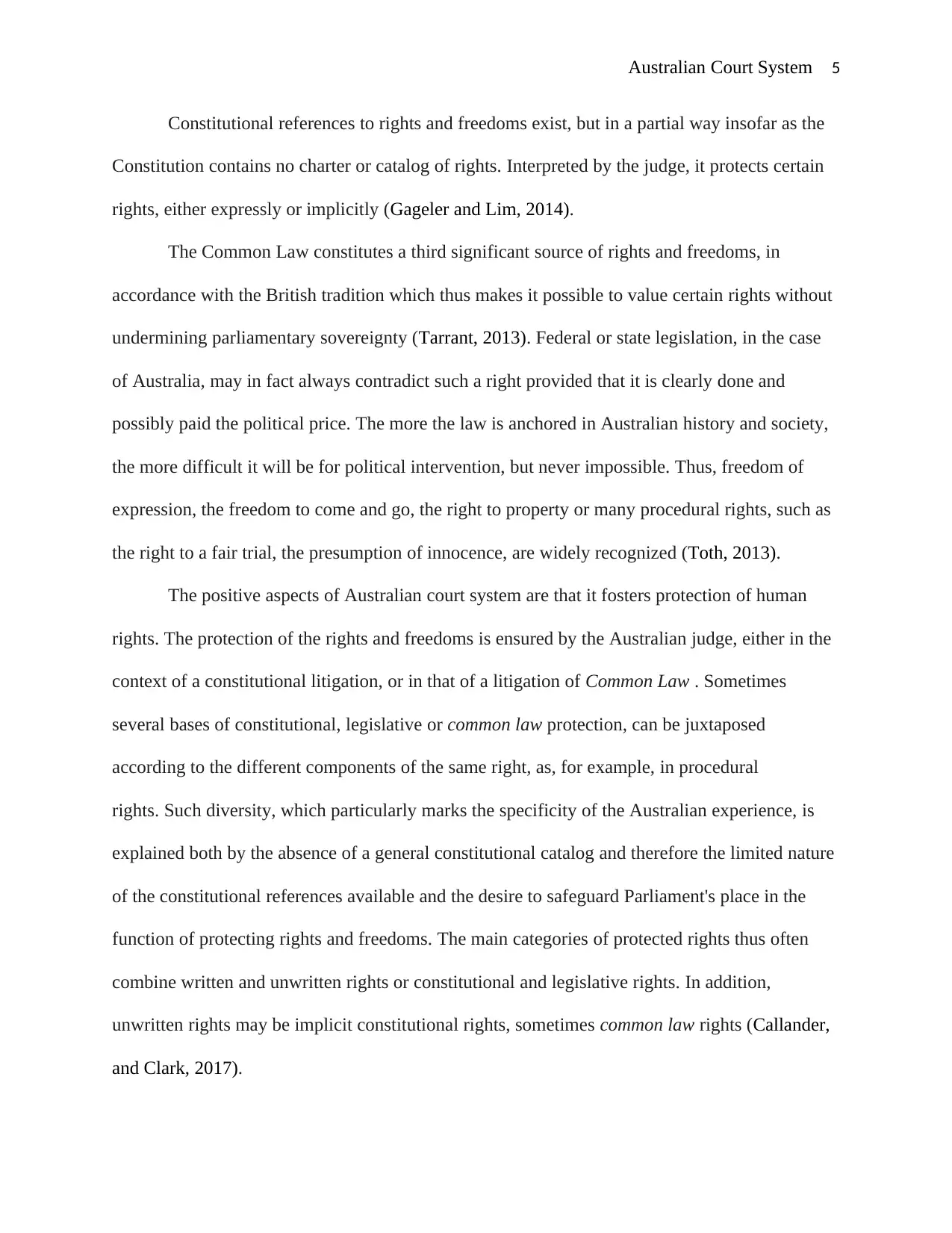
Australian Court System 5
Constitutional references to rights and freedoms exist, but in a partial way insofar as the
Constitution contains no charter or catalog of rights. Interpreted by the judge, it protects certain
rights, either expressly or implicitly (Gageler and Lim, 2014).
The Common Law constitutes a third significant source of rights and freedoms, in
accordance with the British tradition which thus makes it possible to value certain rights without
undermining parliamentary sovereignty (Tarrant, 2013). Federal or state legislation, in the case
of Australia, may in fact always contradict such a right provided that it is clearly done and
possibly paid the political price. The more the law is anchored in Australian history and society,
the more difficult it will be for political intervention, but never impossible. Thus, freedom of
expression, the freedom to come and go, the right to property or many procedural rights, such as
the right to a fair trial, the presumption of innocence, are widely recognized (Toth, 2013).
The positive aspects of Australian court system are that it fosters protection of human
rights. The protection of the rights and freedoms is ensured by the Australian judge, either in the
context of a constitutional litigation, or in that of a litigation of Common Law . Sometimes
several bases of constitutional, legislative or common law protection, can be juxtaposed
according to the different components of the same right, as, for example, in procedural
rights. Such diversity, which particularly marks the specificity of the Australian experience, is
explained both by the absence of a general constitutional catalog and therefore the limited nature
of the constitutional references available and the desire to safeguard Parliament's place in the
function of protecting rights and freedoms. The main categories of protected rights thus often
combine written and unwritten rights or constitutional and legislative rights. In addition,
unwritten rights may be implicit constitutional rights, sometimes common law rights (Callander,
and Clark, 2017).
Constitutional references to rights and freedoms exist, but in a partial way insofar as the
Constitution contains no charter or catalog of rights. Interpreted by the judge, it protects certain
rights, either expressly or implicitly (Gageler and Lim, 2014).
The Common Law constitutes a third significant source of rights and freedoms, in
accordance with the British tradition which thus makes it possible to value certain rights without
undermining parliamentary sovereignty (Tarrant, 2013). Federal or state legislation, in the case
of Australia, may in fact always contradict such a right provided that it is clearly done and
possibly paid the political price. The more the law is anchored in Australian history and society,
the more difficult it will be for political intervention, but never impossible. Thus, freedom of
expression, the freedom to come and go, the right to property or many procedural rights, such as
the right to a fair trial, the presumption of innocence, are widely recognized (Toth, 2013).
The positive aspects of Australian court system are that it fosters protection of human
rights. The protection of the rights and freedoms is ensured by the Australian judge, either in the
context of a constitutional litigation, or in that of a litigation of Common Law . Sometimes
several bases of constitutional, legislative or common law protection, can be juxtaposed
according to the different components of the same right, as, for example, in procedural
rights. Such diversity, which particularly marks the specificity of the Australian experience, is
explained both by the absence of a general constitutional catalog and therefore the limited nature
of the constitutional references available and the desire to safeguard Parliament's place in the
function of protecting rights and freedoms. The main categories of protected rights thus often
combine written and unwritten rights or constitutional and legislative rights. In addition,
unwritten rights may be implicit constitutional rights, sometimes common law rights (Callander,
and Clark, 2017).
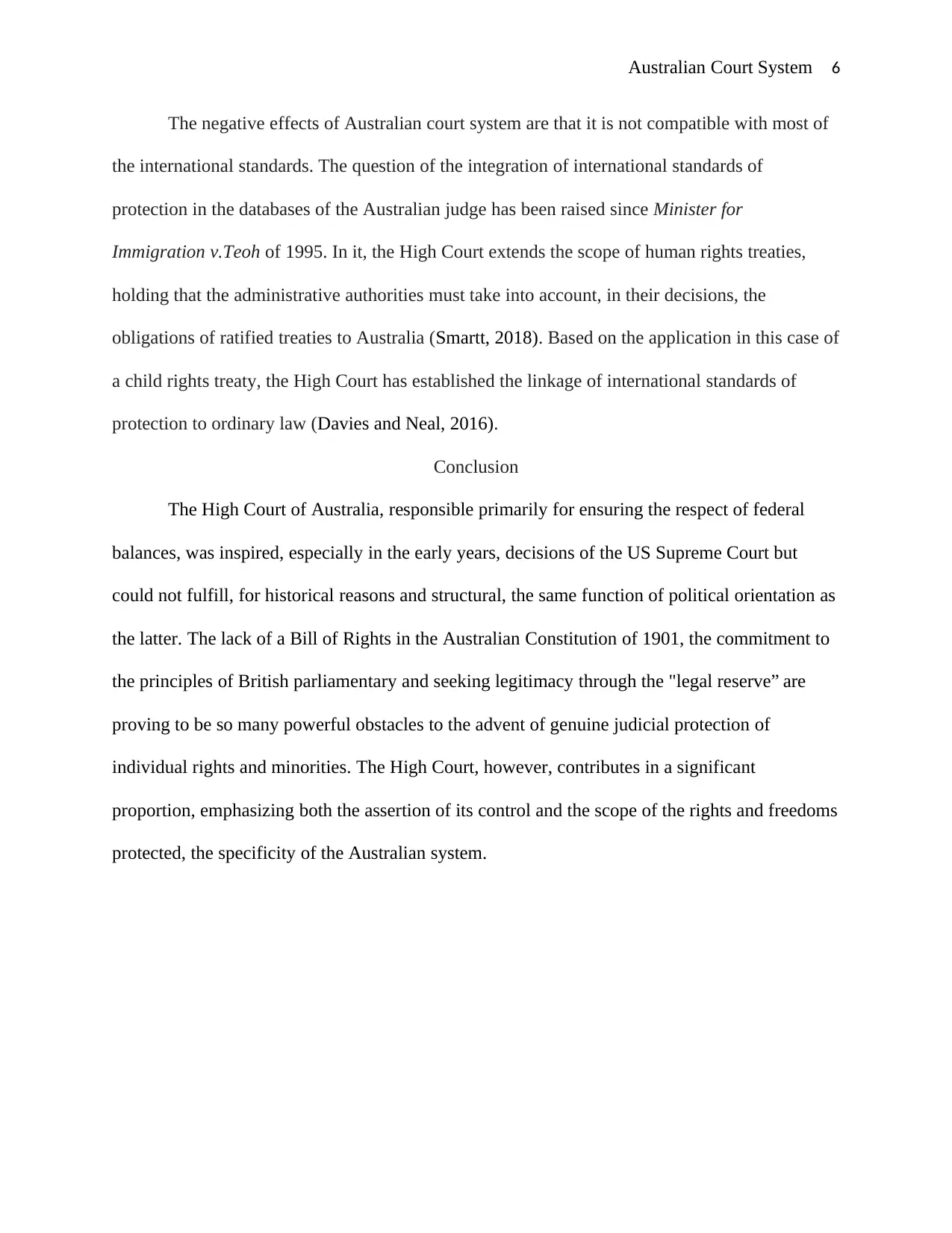
Australian Court System 6
The negative effects of Australian court system are that it is not compatible with most of
the international standards. The question of the integration of international standards of
protection in the databases of the Australian judge has been raised since Minister for
Immigration v.Teoh of 1995. In it, the High Court extends the scope of human rights treaties,
holding that the administrative authorities must take into account, in their decisions, the
obligations of ratified treaties to Australia (Smartt, 2018). Based on the application in this case of
a child rights treaty, the High Court has established the linkage of international standards of
protection to ordinary law (Davies and Neal, 2016).
Conclusion
The High Court of Australia, responsible primarily for ensuring the respect of federal
balances, was inspired, especially in the early years, decisions of the US Supreme Court but
could not fulfill, for historical reasons and structural, the same function of political orientation as
the latter. The lack of a Bill of Rights in the Australian Constitution of 1901, the commitment to
the principles of British parliamentary and seeking legitimacy through the "legal reserve” are
proving to be so many powerful obstacles to the advent of genuine judicial protection of
individual rights and minorities. The High Court, however, contributes in a significant
proportion, emphasizing both the assertion of its control and the scope of the rights and freedoms
protected, the specificity of the Australian system.
The negative effects of Australian court system are that it is not compatible with most of
the international standards. The question of the integration of international standards of
protection in the databases of the Australian judge has been raised since Minister for
Immigration v.Teoh of 1995. In it, the High Court extends the scope of human rights treaties,
holding that the administrative authorities must take into account, in their decisions, the
obligations of ratified treaties to Australia (Smartt, 2018). Based on the application in this case of
a child rights treaty, the High Court has established the linkage of international standards of
protection to ordinary law (Davies and Neal, 2016).
Conclusion
The High Court of Australia, responsible primarily for ensuring the respect of federal
balances, was inspired, especially in the early years, decisions of the US Supreme Court but
could not fulfill, for historical reasons and structural, the same function of political orientation as
the latter. The lack of a Bill of Rights in the Australian Constitution of 1901, the commitment to
the principles of British parliamentary and seeking legitimacy through the "legal reserve” are
proving to be so many powerful obstacles to the advent of genuine judicial protection of
individual rights and minorities. The High Court, however, contributes in a significant
proportion, emphasizing both the assertion of its control and the scope of the rights and freedoms
protected, the specificity of the Australian system.
⊘ This is a preview!⊘
Do you want full access?
Subscribe today to unlock all pages.

Trusted by 1+ million students worldwide
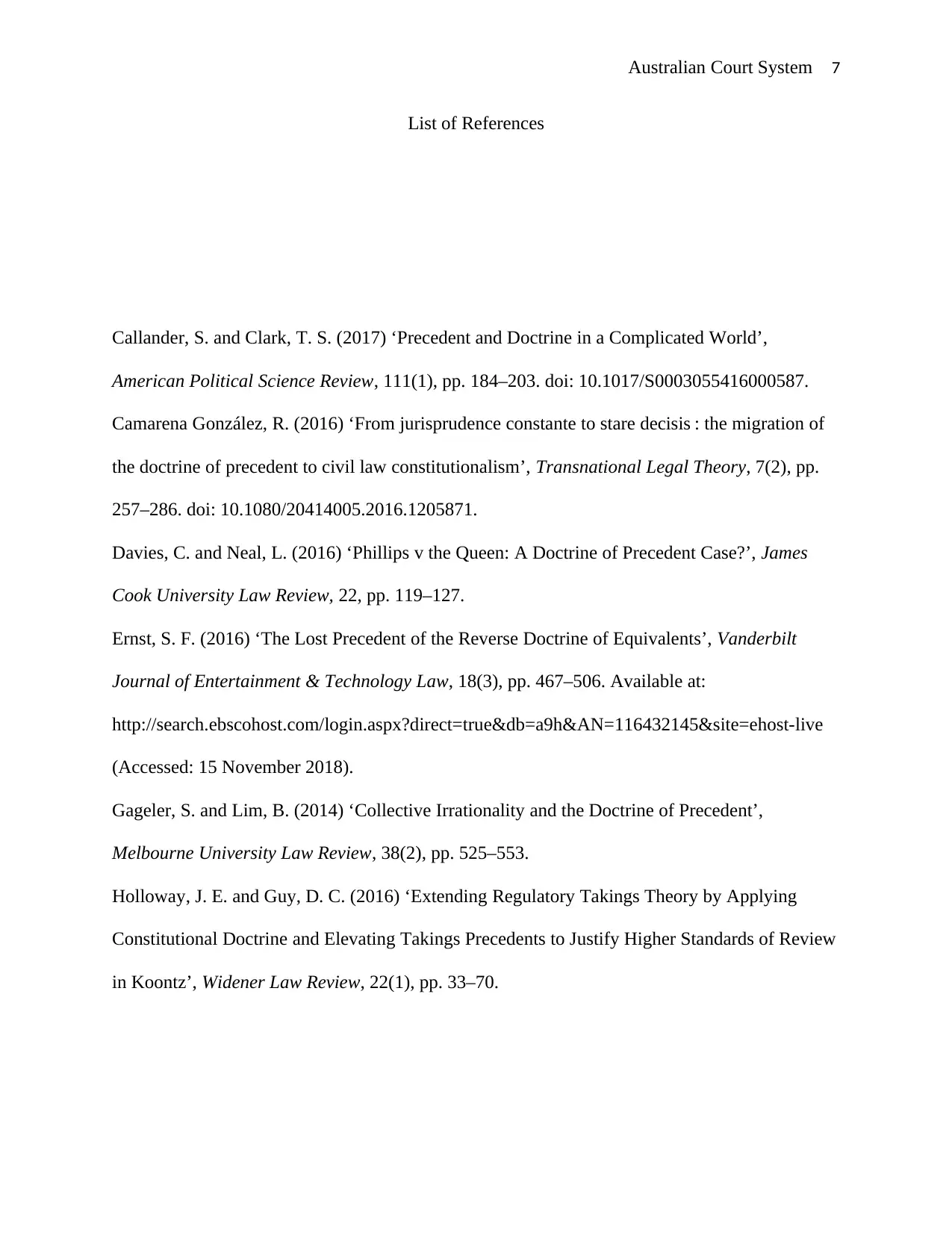
Australian Court System 7
List of References
Callander, S. and Clark, T. S. (2017) ‘Precedent and Doctrine in a Complicated World’,
American Political Science Review, 111(1), pp. 184–203. doi: 10.1017/S0003055416000587.
Camarena González, R. (2016) ‘From jurisprudence constante to stare decisis : the migration of
the doctrine of precedent to civil law constitutionalism’, Transnational Legal Theory, 7(2), pp.
257–286. doi: 10.1080/20414005.2016.1205871.
Davies, C. and Neal, L. (2016) ‘Phillips v the Queen: A Doctrine of Precedent Case?’, James
Cook University Law Review, 22, pp. 119–127.
Ernst, S. F. (2016) ‘The Lost Precedent of the Reverse Doctrine of Equivalents’, Vanderbilt
Journal of Entertainment & Technology Law, 18(3), pp. 467–506. Available at:
http://search.ebscohost.com/login.aspx?direct=true&db=a9h&AN=116432145&site=ehost-live
(Accessed: 15 November 2018).
Gageler, S. and Lim, B. (2014) ‘Collective Irrationality and the Doctrine of Precedent’,
Melbourne University Law Review, 38(2), pp. 525–553.
Holloway, J. E. and Guy, D. C. (2016) ‘Extending Regulatory Takings Theory by Applying
Constitutional Doctrine and Elevating Takings Precedents to Justify Higher Standards of Review
in Koontz’, Widener Law Review, 22(1), pp. 33–70.
List of References
Callander, S. and Clark, T. S. (2017) ‘Precedent and Doctrine in a Complicated World’,
American Political Science Review, 111(1), pp. 184–203. doi: 10.1017/S0003055416000587.
Camarena González, R. (2016) ‘From jurisprudence constante to stare decisis : the migration of
the doctrine of precedent to civil law constitutionalism’, Transnational Legal Theory, 7(2), pp.
257–286. doi: 10.1080/20414005.2016.1205871.
Davies, C. and Neal, L. (2016) ‘Phillips v the Queen: A Doctrine of Precedent Case?’, James
Cook University Law Review, 22, pp. 119–127.
Ernst, S. F. (2016) ‘The Lost Precedent of the Reverse Doctrine of Equivalents’, Vanderbilt
Journal of Entertainment & Technology Law, 18(3), pp. 467–506. Available at:
http://search.ebscohost.com/login.aspx?direct=true&db=a9h&AN=116432145&site=ehost-live
(Accessed: 15 November 2018).
Gageler, S. and Lim, B. (2014) ‘Collective Irrationality and the Doctrine of Precedent’,
Melbourne University Law Review, 38(2), pp. 525–553.
Holloway, J. E. and Guy, D. C. (2016) ‘Extending Regulatory Takings Theory by Applying
Constitutional Doctrine and Elevating Takings Precedents to Justify Higher Standards of Review
in Koontz’, Widener Law Review, 22(1), pp. 33–70.
Paraphrase This Document
Need a fresh take? Get an instant paraphrase of this document with our AI Paraphraser
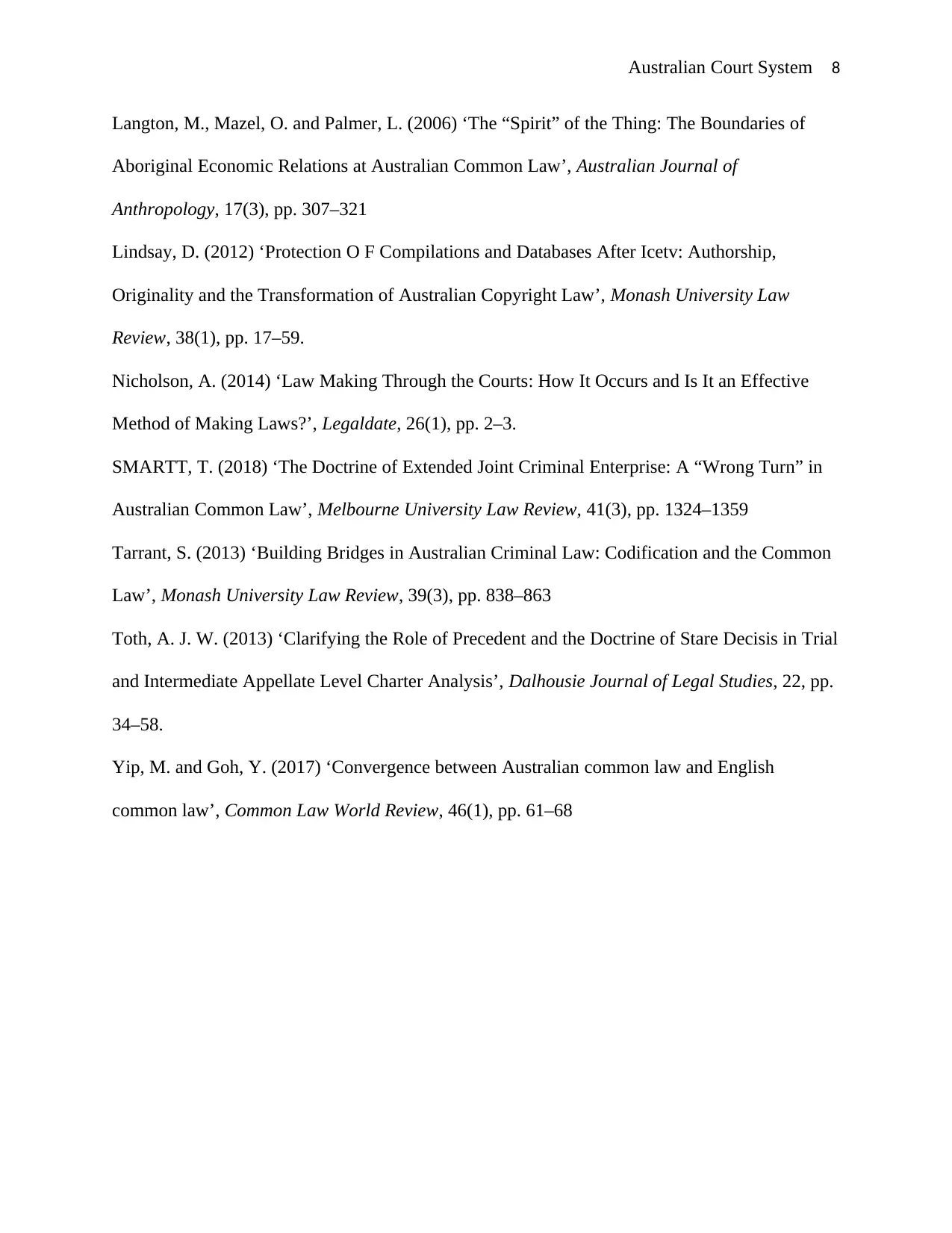
Australian Court System 8
Langton, M., Mazel, O. and Palmer, L. (2006) ‘The “Spirit” of the Thing: The Boundaries of
Aboriginal Economic Relations at Australian Common Law’, Australian Journal of
Anthropology, 17(3), pp. 307–321
Lindsay, D. (2012) ‘Protection O F Compilations and Databases After Icetv: Authorship,
Originality and the Transformation of Australian Copyright Law’, Monash University Law
Review, 38(1), pp. 17–59.
Nicholson, A. (2014) ‘Law Making Through the Courts: How It Occurs and Is It an Effective
Method of Making Laws?’, Legaldate, 26(1), pp. 2–3.
SMARTT, T. (2018) ‘The Doctrine of Extended Joint Criminal Enterprise: A “Wrong Turn” in
Australian Common Law’, Melbourne University Law Review, 41(3), pp. 1324–1359
Tarrant, S. (2013) ‘Building Bridges in Australian Criminal Law: Codification and the Common
Law’, Monash University Law Review, 39(3), pp. 838–863
Toth, A. J. W. (2013) ‘Clarifying the Role of Precedent and the Doctrine of Stare Decisis in Trial
and Intermediate Appellate Level Charter Analysis’, Dalhousie Journal of Legal Studies, 22, pp.
34–58.
Yip, M. and Goh, Y. (2017) ‘Convergence between Australian common law and English
common law’, Common Law World Review, 46(1), pp. 61–68
Langton, M., Mazel, O. and Palmer, L. (2006) ‘The “Spirit” of the Thing: The Boundaries of
Aboriginal Economic Relations at Australian Common Law’, Australian Journal of
Anthropology, 17(3), pp. 307–321
Lindsay, D. (2012) ‘Protection O F Compilations and Databases After Icetv: Authorship,
Originality and the Transformation of Australian Copyright Law’, Monash University Law
Review, 38(1), pp. 17–59.
Nicholson, A. (2014) ‘Law Making Through the Courts: How It Occurs and Is It an Effective
Method of Making Laws?’, Legaldate, 26(1), pp. 2–3.
SMARTT, T. (2018) ‘The Doctrine of Extended Joint Criminal Enterprise: A “Wrong Turn” in
Australian Common Law’, Melbourne University Law Review, 41(3), pp. 1324–1359
Tarrant, S. (2013) ‘Building Bridges in Australian Criminal Law: Codification and the Common
Law’, Monash University Law Review, 39(3), pp. 838–863
Toth, A. J. W. (2013) ‘Clarifying the Role of Precedent and the Doctrine of Stare Decisis in Trial
and Intermediate Appellate Level Charter Analysis’, Dalhousie Journal of Legal Studies, 22, pp.
34–58.
Yip, M. and Goh, Y. (2017) ‘Convergence between Australian common law and English
common law’, Common Law World Review, 46(1), pp. 61–68
1 out of 8
Related Documents
Your All-in-One AI-Powered Toolkit for Academic Success.
+13062052269
info@desklib.com
Available 24*7 on WhatsApp / Email
![[object Object]](/_next/static/media/star-bottom.7253800d.svg)
Unlock your academic potential
Copyright © 2020–2025 A2Z Services. All Rights Reserved. Developed and managed by ZUCOL.





